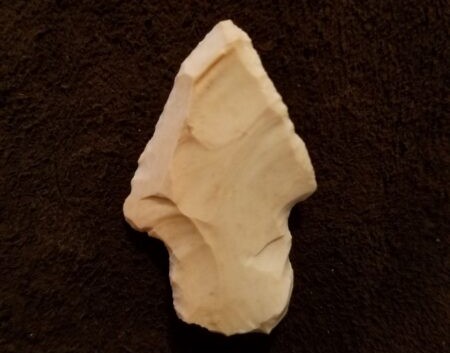Native American projectile points have been made in the Americas from the time of the earliest Paleo-American cultures through the 16th century. The points in these collections are made of local stone in a variety of colors; the majority of the points are made of Burlington chert, but there are also points made of Mozarkite chert and jasper chert. Native Americans also developed the technology of heat-treating chert to further vitrify it, which makes the stone stronger and more glass-like, producing a sharper tool.
While projectile points served as functional, utilitarian tools, they also demonstrate the skills and artistry of ancient Native American flintknappers. Projectile points are important indicators of technological advancement as well as of cultural traditions. Archaeologists have suggested that projectile points can even reveal the personalities of the flintknappers through the artistic choices that they make while creating an elaborately designed point.
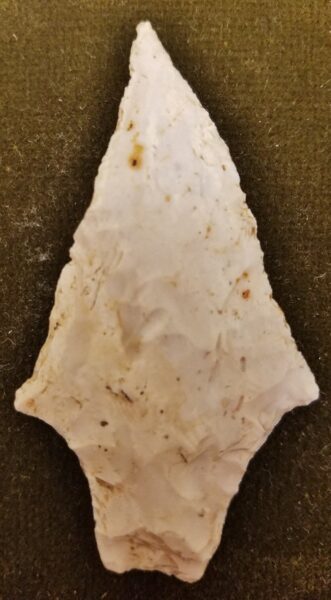
Middle Woodland Havana Tradition
Early Woodland period
Chert, L. 3.5 cm x W. 0.5 cm x H. 6.5 cm
History Museum on the Square collection Panel #8
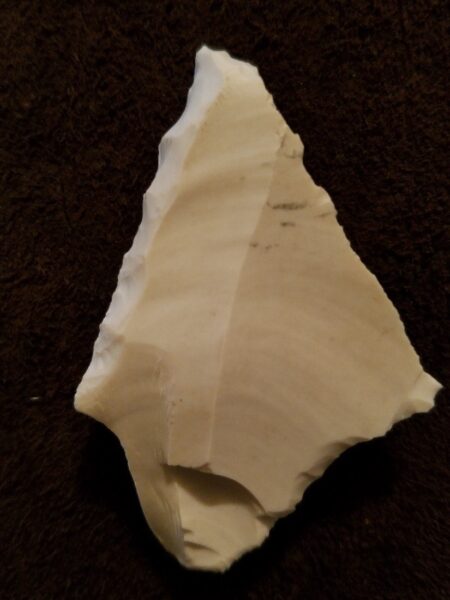
Reproduction made by Chaney Jewell, 2016
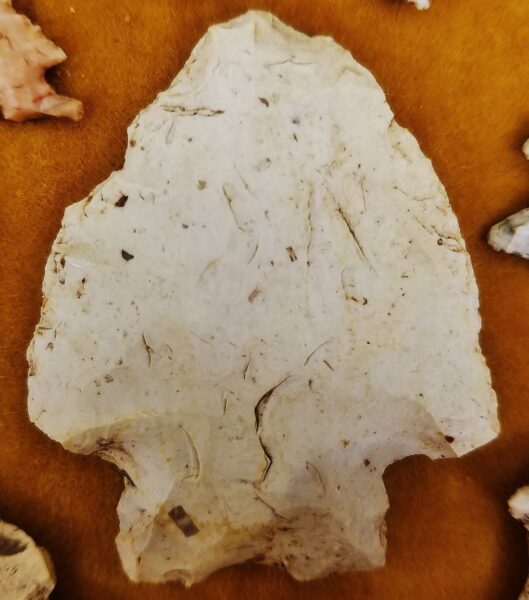
Archaic Great Plains cultures
Late Archaic period
Chert, L. 4.6 cm x W. 0.5 cm x H. 5.5 cm
History Museum on the Square collection Panel #11
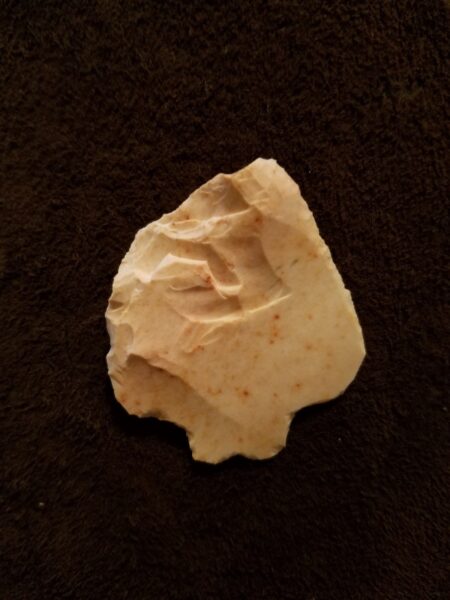
Reproduction made by Chaney Jewell, 2016
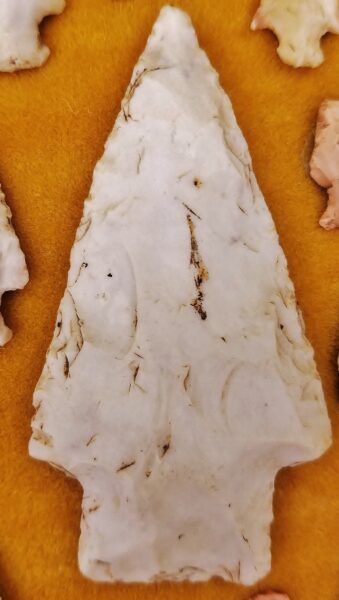
Archaic Great Plains cultures
Archaic period
Chert, L. 4 cm x W. 0.25 cm x H. 7 cm
History Museum on the Square collection Panel #13
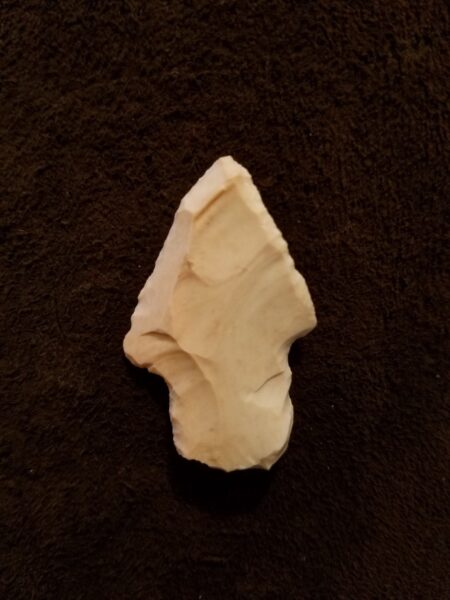
Reproduction made by Chaney Jewell, 2016
As with ancient stone projectile points from other parts of the world, form follows function for ancient Native American stone points. Although these three projectile points come from different time periods, the Dickson point and the Scottsbluff point both have a long, triangular shape and straight sides. The Afton point, although contemporary with the Scottsbluff point, is shorter, wider and rounder, with a shorter stem. Nevertheless, the similar thickness, weight, and relatively large size of all three of these stone points suggests that they all served as points for a spear or a large dart – perhaps used for different, specialized purposes. Researched by Chaney Jewell
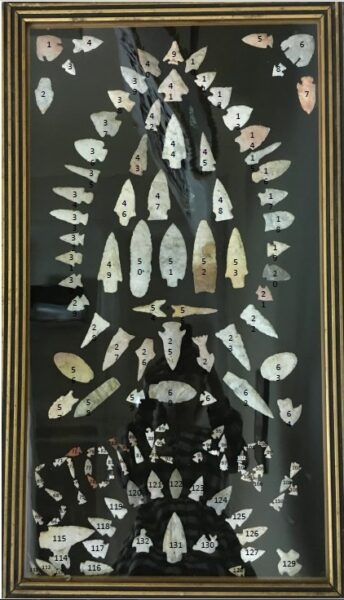
Native American cultures of the Midwest
Middle Paleo-American period – Historic period (8900 BCE-1540 CE)
(Modern Eccentric Points: 20th century)
Assorted stone in a glass-and-wood frame
Point dimensions range from: L. 1-4 cm x W. approx. 2-6 mm x H. 1-11 cm
History Museum on the Square Panel 16
Researched by Paige Whitcomb
Side-Notched Points:
Points #3, and #20: Raddatz Points
Middle Archaic period (5000-2500 BCE)
Points #17, #42, and #57: White River Points
Middle Archaic period (5000-2500 BCE)
Point #28: Rice Side-Notched Point
Late Woodland period (450-950 CE)
Point #35: Breckenridge Point
Early Archaic period (7800- 5000 BCE)
Points #75, #83, #86, #110, and #113: Cahokia Points
Early-Late Mississippian period (950-1540 CE)
Points #89, #90, #94, #104, and #109: Morris Points
Early-Late Mississippian period (950-1540 CE)
Side-Notched Points have horizontal side notches in the stem of the point that cause the barbs of the points to look squared off. These points share the typical tool functions of projectile points; White River Points specifically functioned as pendants and drills, and the Rice Side-Notched Points were used on darts. The Morris Points and Cahokia Points were used as arrowheads; however, Cahokia Points are often more intricate in design, and they have been found unused in burials, likely having a ceremonial function as a burial offering.
Corner-Notched Points:
Projectile Point #1: Afton Point
Late Archaic period (2500- 800 BCE)
Projectile Points #5, #29, #36, #59, and #61: Snyders Points
Middle Woodland period (200 BCE- 450 CE)
Projectile Points #7, #43, and #45 St. Charles Points
Early Archaic period (7800- 5000 BCE)
Projectile Points #8, #19, #21, #32, and #128: Kings Points
Late Archaic-Late Woodland/Mississippian periods (2500 BCE-1540 CE)
Projectile Point #9: Stealth Point
Late Archaic period (2500- 800 BCE)
Projectile Points #12, and #13: Williams Points
Late Archaic period (2500- 800 BCE)
Projectile Points #65, #66, #67, #68, #69, #70, #71, #72, #73, #74, #78, #80, #84, #85, #88, #91, #100, #101, and #111: Scallorn Points
Late Woodland- Middle Mississippian periods (450- 1350 CE)
Projectile Points #76, #79, #93, #99, #103, #105, #81, #82, #95, #96, and #106: Little Sac Points
Late Archaic period (2500- 800 BCE)
Corner-Notch Points have angular notches in the stem of the points, which cause the barbs of the points to look pointed and often “U”-shaped. Scholars have only determined the specific function of three of these points: the Scottsbluff Point, The Kings Point, and the Scallorn Point. The Scottsbluff Points were used specifically as knives, the Kings Points were used on darts, and the Scallorn Points were used as arrowheads.
Stemmed Points:
Projectile Points #2, #15, and #26: Dickson Points
Early Woodland period (800-200 BCE)
Projectile Points #4, #120, #121, #124: Jakie Points
Late Woodland-Middle Mississippian periods (450- 1350 CE)
Projectile Point #10: Montgomery Point
Late Woodland-Middle Mississippian periods (450-1350 CE)
Projectile Points #14, and #64: Taney Points
Early Archaic period-Middle Archaic period (7800- 2500 BCE)
Projectile Point #16: Table Rock Point
Late Archaic period (2500-800 BCE)
Projectile Point #118, #119, and #123: Rice-Lobed Points
Early Archaic period (7800- 5000 BCE)
Projectile Points #18, #22, #23, and #27: Scottsbluff Points
Early Archaic period (7800- 5000 BCE)
Points #30, #108, and #125: San Patrice St. Johns Variety Points
Middle-Late Paleo-American period (8900- 7800 BCE)
Points #31, #37, #38, #41, #117, #126, and #127: Saratoga Points
Late Archaic period (2500-800 BCE)
Points #33 and #34: Hardin Points
Early Archaic period (7800- 5000 BCE)
Points #39, #40, and #46: Hidden Valley Points
Early Archaic period (7800- 5000 BCE)
Points #25, #44, #47, #48, #49, #53, #60, #115, #116, #131: Etley Points
Late Archaic period (2500-800 BCE)
Stemmed Points have long, pronounced stems and small notching or no notching at all. The majority of the stemmed points in this collection also have contracting stems. Scholars have been able to determine the specific function of the San Patrice St. Johns Variety Points, which functioned specifically as dart points.
Modern Eccentric Zoomorphic Points:
Points #24, #97, #114, #129, #130, and #132: Flint Eccentric Points
Contemporary Midwest American cultures, 20th century
Eccentric Zoomorphic Points have not been classified in formal point guides, and it is highly likely that these points were created by modern flintknappers, who show off their flintknapping skills by creating new and different designs. The anamorphic shapes of Points #129, #130, #132, and #114, as well as Point #94, #95, and #97 appear to be aesthetically oriented creations, as they could not be used as functional projectile points. It is important to note that these points are not “fakes,” however, as flintknappers make these points solely with the intent of experimentation and are not trying to trick people into believing that their replicas and creative pieces are authentic points. Such creative points are known as “art lithics.”
Basal Notched Points, Unidentified Points, and Biface Tools:
Projectile Point #6: Calf Creek Point
Middle Archaic period (5000-2500 BCE)
Projectile Point #11: Smith Point
Late Archaic period (2500-800 BCE)
Points #51, and #107: Unidentified Points
Points #50, #56, and #63: Biface Tools
Middle Paleo-American-Late Mississippian period (8900 BCE-1540 CE)
This display consists of Basal Notched Points, Unidentified Points, and Biface Tools. The Basal Notched Points are the Calf Creek Point and the Smith Points, whose notching does not come from the side or the corner of the stem, but from the bottom of the stem’s base; this causes the barbs on the points to look like upside down “U” shapes. Archaeologists have discovered points #51 and #107 Unidentified Points, but these have atypical features and cannot yet be classified. Points #50, #56, and #63 are Biface Tools because they have distinctive rounded and reshaped forms; these are often projectile points that were broken during manufacturing or use and were reshaped to function as scrapers or knives.
Unnotched Points:
Point #52: Searcy Point
Early Archaic period (7800-5000 BCE)
Points #54, and #55: Dalton Points
Middle-Late Paleo-American period (8900-7800 BCE)
Points #58, and #62: Packard Points
Middle-Late Paleo-Native American period (8900-7800 BCE)
Points #77, #87, #92, #98, #102, and #112: Fresno Points
Middle Mississippian period (1150-1350 CE)
Point #122: Nodena Point
Middle-Late Mississippian period (1150-1540 CE)
Unnotched Points do not have any notches in the stem. The Fresno Points and Nodena Points were used specifically as arrowheads. The Dalton Points would be reformed and used as drills or awl forms, and the Searcy Point would often be reworked into scrapers, drills, or awl forms. The style of the unnotched stems made it possible for Native Americans to easily attach the points to wooden shafts.
For more information, you may contact the researcher(s) noted in the title of this exhibit entry, or Dr. Billie Follensbee, the professor of the course, at BillieFollensbee@MissouriState.edu

